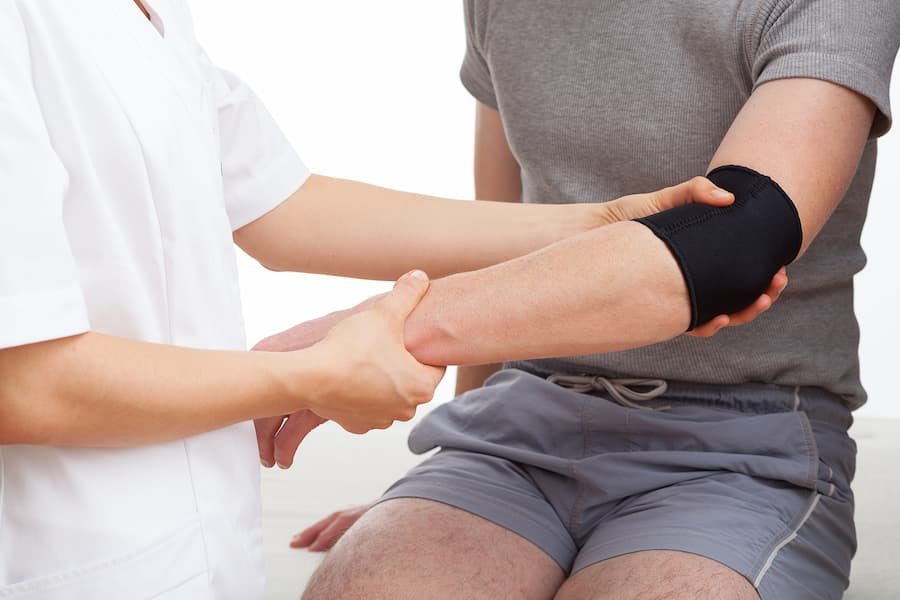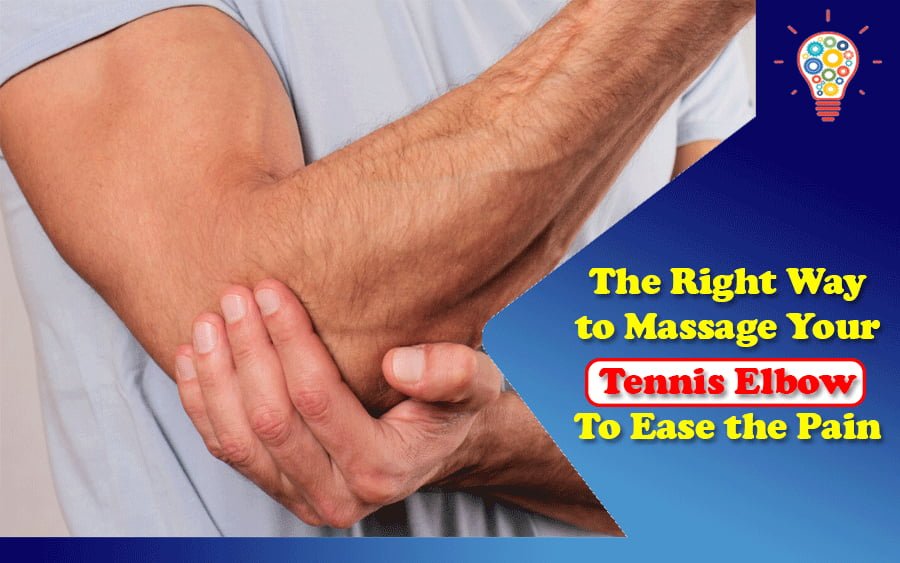Table of Contents
What Is Tennis Elbow?
Tennis elbow is very much an arm and wrist ailment that creates discomfort and inflammation. Despite its name, this ailment does not require you to be a tennis player to have elbow discomfort. Tennis Elbow Massage is a simple and efficient approach to alleviate discomfort. Such tennis elbow massages are meant to reduce discomfort from epicondylitis without using painkillers or a tennis elbow brace.
Symptoms and Causes of Tennis Elbow
Indications
Tennis elbow can cause discomfort to extend from the outside of your elbow to your forearm & wrist. Pain and weakness may make it harder to:
- Shake your hands or take a hold of anything.
- Turn the handle on the entrance.
- Take a coffee cup in your hand.
When Should You See a Specialist?
If self-care measures like rest, ice, and over-the-counter pain medicines don’t help your elbow discomfort and soreness, see your specialist.
Consequences
Tennis elbow is a muscular strain and overuse ailment. Repetitive contraction of the forearm muscles, which are used to straighten and lift your hand and wrist, is the reason. The tendons that connect the forearms muscle to the bone prominence on the exterior of your elbow may rupture as a consequence of repetitive movements and tissues strain. Tennis elbow can be caused by a variety of activities, including frequent usage of the backhand stroke with poor technique, as the name implies. Tennis elbow can also be caused by a variety of other common arm movements, such as:
- Using plumbing equipment
- Painting
- Screw-driving
- Chopping up items for preparation, especially meat
- Use of a computer mouse regularly
How Does Tennis Elbow Massage Therapy Helps?
Massage treatment, which is conducted by a professional Tennis Elbow massage therapist, includes manipulating tendons and other soft tissues within the body using various pressures, motions, and methods. Tennis Elbow Massage treatment may be utilized to relieve stress and frustration, relieve symptoms, mend injuries, and enhance wellbeing by slowing down your nervous system.
Tennis Elbow Massage Advantages

Massage treatment is good for everyone, but it has been shown to aid those with cancers, cardiovascular disease, stomach issues, tennis elbows and fibromyalgia. Any health circumstances should be mentioned to your doctor before your first appointment. You can also use a full-body massage chair that features arm massage to help with Tennis Elbow pain and to relax the body and mind. A few of the advantages of Tennis Elbow massage treatment are listed below.
Lower Tension and Depression
According to research, the sensation of peace that comes after a massage might help to reduce tension and depression. The sympathetic nervous system, which drives your “fight or flight” response in stressful situations, and the parasympathetic nervous system, which concentrates on routine and day-to-day processes that ultimately resulted in stress relief and rest, are the two nervous processes in your body. Massage is known to boost the parasympathetic nervous system, which might help you feel less anxious.
It Helps You Sleep Better
A massage can lower cortisol (a stress hormone) and raise levels of serotonin and dopamine, neurotransmitters that help to keep your attitude in check. Tennis Elbow Massage treatment has been demonstrated to help those with insomnia caused by menopause and congestive cardiovascular failure in investigations.
Reduces Muscular Strain and Discomfort
Massage has been studied to see if it can assist with discomforts such as acute back pain, neck discomfort, headaches, and knee pain. The findings suggest that treatment may be temporary rather than long-term, and that having a 60-minute massage numerous times per week had greater outcomes than obtaining fewer or quicker tennis elbow massages.
Immune Function Is Improved
Is it true that a massage might help your immune response? According to research, frequent massages boost the number of white blood cells in your body, which fight illnesses.
Relieves Constipation
An abdominal massage may help those who are experiencing constipation after surgery, according to research.
Fibromyalgia Symptoms Are Reduced
Massage therapy, when used for five weeks, has been demonstrated to relieve symptoms of fibromyalgia, a chronic condition that causes muscular and joint pain and tiredness.
Pain Relief for Cancer Patients
The physical and emotional toll of cancer therapy is significant for those who are enduring it. Many people have resorted to tennis elbow massage to help them cope with cancer discomfort, relax, and enhance their quality of life. There have been numerous research, some of which claim massage treatment has no effect on cancer pain and others which claim it helps.
Who Should Consider Getting a Massage?

A tennis elbow massage can assist a lot of people – it’s a terrific method to promote wellbeing, relieve pain, and more. If you have a medical issue, you should consult your doctor and speak with your massage therapist about it. A prenatal massage can help relieve discomfort and oedema in pregnant women.
What are the Trigger Points of the Tennis Elbow?
Put simply, trigger points are the tight bumps found by therapists in your tendons. They begin as little lumps that gradually become larger over time, subsequently generating discomfort, but even before that, they induce aberrant tightening of the muscles they are in.
Repeated actions contract tendons & generate trigger points, which constrict the muscles even more. This stiffness puts additional strain on the lateral epicondyle attachment. As a result, the following significant discrepancies emerge.
- Instead of merely repetitive activities creating stress, aberrant tension is added to the mix.
- Trigger points may be painful in and of themselves.
Directly
Tennis elbow is caused by aberrant strain in the forearm muscles that connect to the lateral epicondyle on the exterior of the elbow, as previously mentioned.
Indirectly
Trigger points can relate pain to areas other than the trigger points themselves. Many people refer discomfort to the elbow to simulate or exaggerate the agony of a tennis elbow injury. The same actions or exercises that aggravate the injury on the exterior of the elbow also aggravate the trigger points in this scenario. As a result, the very same activity might result in both direct and indirect pain. Finally, trigger point pain can sensitize the neurological system, making any pain feel more intense.
The Proof That Trigger Points Are a Major Source of Trigger Points Is Overwhelming
There’s no denying that trigger points are a major contributor to tennis elbow. Scientists have discovered that they are caused by activities and that they force muscles to tense, which in turn generates stress. Furthermore, compared to non-patients, tennis elbow victims have a higher number of trigger points, and trigger point treatment has been demonstrated to give excellent relief.
Diagnosis of Tennis Elbow
Let’s take a look at the process of diagnosing tennis elbow. The tests are straightforward to do on your own, but they should be discussed with a specialist.
Tennis Elbow Signs
Tennis elbow causes discomfort on the exterior of your elbow that is increased by actions such as bending your wrist or fingers backwards or clutching.
- Tennis elbow may be diagnosed with simple diagnostics.
- To diagnose tennis elbow, a doctor will do two basic tests.
Tenderness is Checked
Check the exterior of your elbow for any signs of injury. The bone hump (lateral epicondyle) and 1-2 cm towards your wrist will be quite sore (the tendon).
Tests of inducement
The Mills and Cozens tests entail bending your wrist forward to contract the tendons at the rear of your arm that link to the lateral epicondyle, and bending your hand back the opposite way against the opposition. These tug on the wounded region in the tennis elbow, so if they generate discomfort, that’s a good sign.
Tests to See if a Trigger Point Is Involved
Palpation is a simple method of determining whether or not something. This is just looking for trigger points in your forearm muscles. Trigger points will almost probably cause the muscles to tighten, thus they will be involved.
Best Massage Techniques for Tennis Elbow

Tennis elbow is a long-term, unpleasant ailment that is prone to recurrence. Because allowing the elbow to rest and heal might take anywhere from 6 months to 2 years, it’s critical to avoid reinjury. Heat or cold compresses, as well as nonsteroidal anti-inflammatory medicines (such as Ibuprofen) and paracetamol, can help reduce inflammation and discomfort. Tennis elbow can be relieved and healed considerably faster with deep tissue massage to the forearm than with rest alone.
Friction Massage
Deep tissue massage improves blood flow, and when combined with frictional treatment applied to the muscles on the joint, excellent outcomes are achieved. Friction treatment breaks up scar tissue, relieves pain, releases muscle spasms, and improves mobility, whereas deep tissue massage techniques break up scar tissue, relieve pain, release muscle spasms, and enhance flexibility.
It’s vital to remember that, to avoid reinjury, patience is required when treating tennis elbow; it’s easy to resume normal activities as soon as the symptoms subside. Structures that have been damaged are still fragile and can easily rupture again before the mending process is complete. A few massage treatments and prudence as the tissues are gradually reinforced will guarantee that injuries recover in the long run.
Burn and Hold Friction
This action, like the preceding tennis elbow massage, increases fluid flow in the tendons around the afflicted joint. This activity, on the other hand, is more difficult. Please be kind and quit if you start to feel uncomfortable.
- Begin by holding your afflicted arm in front of your body.
- Next, wrap your other hand’s fingertips around your forearm, right below the elbow.
- Then, using your fingers, twist the flesh of your elbow outwards. For 5 to 10 seconds, stay in this position.
- Repeat by moving your fingers lower a few millimeters. Continue until your wrist is reached.
- Return up the arm after you’ve reached the wrist. Use the same procedure as before, but this time rotates the skin inward.
This practice, when done correctly, can give rapid relief from the symptoms of a golfer’s elbow without the need for painkillers.
Stretch and Pin
Golfer’s elbow is caused by swelling joints pressing on bony structures in the arm, causing discomfort. This massage aids in the reduction of swelling, which adds to the discomfort.
- Grab your forearm muscles immediately beneath your elbow with your afflicted arm held in front of you.
- Next, aggressively compress your arm muscles. Throughout exercise maintain a firm hold.
- Make a fist with your hands. Curl it down as though you’re attempting to connect your knuckles to your wrist. Hold for a few moments.
- Return to the starting position and perform 3–4 times more.
- You will sense stretching underneath the fingertips that are tightening your muscles while executing this tennis elbow therapy.
If you have active symptoms, apply an ice pack for 10 minutes after practicing this tennis elbow massage therapy. That will improve the inflammatory mediator’s properties of this workout. To get comfort, perform these massages as required. To get rid of tennis elbow discomfort for good, incorporate a seven-step routine into your treatment plan.
Conclusion
Tennis Elbow is a situation in which specific parts hurt badly due to various reasons hurt, but there are a few techniques available that can help us to ease this pain.
Read also: Five Tips for Dealing with Chronic Pain

